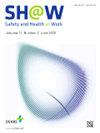基于ART模型的焊接烟尘暴露影响因素定量分析
IF 2.9
3区 医学
Q1 PUBLIC, ENVIRONMENTAL & OCCUPATIONAL HEALTH
引用次数: 0
摘要
工业作业产生的焊接烟雾对健康构成严重威胁。本研究旨在利用建筑材料企业粉尘暴露评估先进REACH工具(ART)对关键因素进行分析,探讨影响焊接烟尘暴露变化的因素。方法采用ART模型评价和实测数据对18家建材企业粉尘暴露进行比较。多重协方差分析确定了与田间条件一致的关键影响因素。最后通过相关分析和回归分析评价了这些因素与粉尘暴露的关系。结果ART模型在第95百分位与现场数据的一致性最高。相关分析和回归分析表明,水分含量、地表污染/排放和粉尘粒径是主要影响因素。结论降低职业健康风险应优先控制含水率,其次是粉尘粒径和表面污染/排放。有针对性的控制这些参数支持可操作的策略,以减少职业健康风险的焊接烟雾暴露。本文章由计算机程序翻译,如有差异,请以英文原文为准。
Quantitative Analysis of the Factors that Influence Welding Fume Exposure via ART Modelling
Background
Welding fumes from industrial operations pose serious health risks. This study aimed to investigate the factors driving changes in welding fume exposure by analyzing key factors using the Advanced REACH Tool (ART) for dust exposure assessment in building materials enterprises.
Methods
The dust exposure of 18 building materials enterprises was compared using ART model assessments and measured data. Multiple covariance analysis identified key influencing factors consistent with field conditions. Finally, correlation and regression analyses evaluated the relationships between these factors and dust exposure.
Results
The ART model showed the highest agreement with field data at the 95th percentile. Correlation and regression analyses identified moisture content, surface contamination/emissions, and dust particle size as the main influencing factors.
Conclusion
Mitigating occupational health risks requires prioritized control of moisture content, followed by dust particle size and surface contamination/emission. Targeted control of these parameters supports actionable strategies to reduce occupational health risks from welding fume exposure.
求助全文
通过发布文献求助,成功后即可免费获取论文全文。
去求助
来源期刊

Safety and Health at Work
Social Sciences-Safety Research
CiteScore
6.40
自引率
5.70%
发文量
1080
审稿时长
38 days
期刊介绍:
Safety and Health at Work (SH@W) is an international, peer-reviewed, interdisciplinary journal published quarterly in English beginning in 2010. The journal is aimed at providing grounds for the exchange of ideas and data developed through research experience in the broad field of occupational health and safety. Articles may deal with scientific research to improve workers'' health and safety by eliminating occupational accidents and diseases, pursuing a better working life, and creating a safe and comfortable working environment. The journal focuses primarily on original articles across the whole scope of occupational health and safety, but also welcomes up-to-date review papers and short communications and commentaries on urgent issues and case studies on unique epidemiological survey, methods of accident investigation, and analysis. High priority will be given to articles on occupational epidemiology, medicine, hygiene, toxicology, nursing and health services, work safety, ergonomics, work organization, engineering of safety (mechanical, electrical, chemical, and construction), safety management and policy, and studies related to economic evaluation and its social policy and organizational aspects. Its abbreviated title is Saf Health Work.
 求助内容:
求助内容: 应助结果提醒方式:
应助结果提醒方式:


